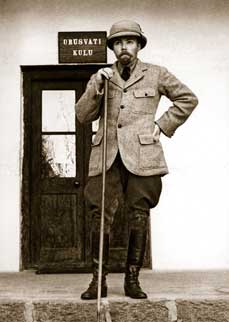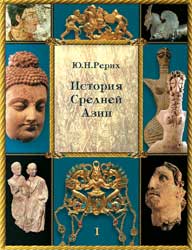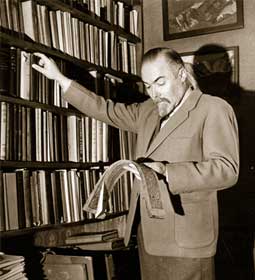Once the expedition had been completed, enormous scientific material that had been collected on route was passed on to the Institute of Himalayan Studies “Urusvati” established in July of 1928. As L. Shaposhnikova, major modern researcher of the Roerich family life and its creative work, writes in her study “The Light of the Morning Star” that this material “was the first precious grain of that new science of which the Living Ethics wrote and the Teachers standing high on the stairs of cosmic evolution spoke”[3, pp. 79-115]. For more than 10 years, Yuri Roerich was the institute’s Director without interruptions. Determining the Institute goals, he wrote: “Comprehension of the main ways of mankind’s development is a step to understanding one’s own personality. Turning back to the past, we reveal the present for ourselves. <…> A forgotten civilization is concealed in the mountains; it preserves ancient wisdom and culture. It is here that the science that has reached a dead end can find its renovation. Ancient wisdom is the key with which archeologist and naturalist open secrets of the Oriental culture. <…> Again a time is coming when the Oriental knowledge penetrates into our life and subordinates to itself science”[4, p. 200]. In 1934 – 1935, Y. Roerich together with N. Roerich undertook an expedition to Manchuria and Inner Mongolia organized on the initiative of the US Department of Agriculture with the purpose of collection of seeds of drought resistant plants that prevent erosion of soils and the spreading of pests. Beside purely scientific knowledge, the expedition also pursued a social and cultural aim – the creation on the territory of Manchuria and, afterwards, of Inner Mongolia, of agricultural cooperatives on the basis of wide public collaboration. As a distinguished encyclopedic-scientist, Yuri Roerich was elected a member of the Royal Asian Society in London, the Asian Society in Bengal, the Paris Geographic Society, the American Archeological and Ethnographical Society, and many others. Yuri Roerich spent more than 35 years abroad, lived in India for a long time. Nevertheless, he always remained a true patriot of his Motherland, and never acquired foreign citizenship. When fascist Germany attacked the Soviet Union, Yuri Roerich immediately sent a telegram to the Soviet Embassy in London with a request to register him as a volunteer in the Red Army, but received a refusal.
In August of 1957, Y. Roerich returned to Moscow from India. It became possible thanks to N. Khruschev’s personal involvement; he had met Yuri Roerich during his official visit to India. Only after that, Y. Roerich got Soviet citizenship and permission to come back to his Motherland. In Moscow, Yuri Roerich started working in the Institute of Oriental Studies of the USSR Academy of Science and headed the “Section of Indian Philosophy and Religious History”. For almost three years spent in the Soviet Union (August 1957 – May 1960), he carried out work of incredible scope, compared to a whole human life. Yuri Roerich revived scientific traditions of the Russian Oriental Studies, created a Russian school of Tibetan Studies, and thanks to him, for the first time in the USSR, started to be taught. Finally, he laid the foundations for a new science – Nomadistics (study of nomad tribes). For a short time during his activities in Moscow, Yuri Roerich prepared for publication a Tibetan-Russian-English dictionary in several tomes with parallels in Sanskrit and several articles and scientific studies. On Yuri Roerich’s initiative, works on translation and publication of ancient philosophic and literary monuments of the East were renewed. He revived the famous series “Biblioteca Buddhica”, founded by the outstanding Russian Orientalist S. Oldenburg in 1897 and dedicated to Buddhist philosophy, religion and art. Yury Roerich worked as the science editor for A. Vostrikov’s book “Tibetan Historical Literature” and the fundamental Buddhist treatise “Dhammapada” (a collection of Buddha’s quotations). This literary monument of the ancient Indian philosophic thought became an important stage in the study of Buddhism in this country.
Yuri Roerich’s fundamental scientific study “The History of Middle Asia” that remained in the form of manuscripts and on which he had worked for many years should be especially noted. He started working on it in India and planned to complete it – but did not complete – in his motherland. Using the term “Middle Asia”, Yuri Roerich meant the vast territory from the Caucasus to Great Khingan and from the Himalayas to Altai. This study is a cultural and historical review of the most important state and cultural formations of the huge territory of Eurasia. Presently, the International Center of the Roerichs released the 1st volume of this unique study. Yuri Roerich’s return to Russia and acquisition of Soviet citizenship was a courageous and selfless step, which took into account that the USSR ruling circles had for a long time formed a distorted impression of this outstanding family in the public mind. It is Yuri Roerich to whom we are obliged for having an opportunity to get widely acquainted with the multi-faceted creative heritage of his parents – Nicholas and Helena Roerich. His parents’ long cherished dream to come back to their Motherland was never realized while they were alive. Their elder son, Yuri Roerich, who returned their good name and great heritage to the Soviet Union, nevertheless, realized it. He brought to his own Motherland part of his parents’ legacy: more than 500 paintings by his father, a huge library and valuable objects. Thanks to Y. Roerich’s direct participation, not only bans on everything associated with the Roerichs’ names were lifted, but also multiple myths on their life and creative work fell to pieces. Thanks to Yuri Roerich, people around him learnt about the essence and the main concept of the teaching of the Living Ethics, or Agni Yoga. It was he who started the Roerich cultural movement in the USSR. With Yuri Roerich’s participation and support, the first N. Roerich’s exhibitions were organized: first in Moscow (April of 1958), and then in Leningrad, Riga, Kiev, Tbilisi, and other cities. For the first time, Y. Roerich managed to raise the question at the governmental level on the establishment of the N. Roerich Museum in the country. For this purpose, he passed on as a gift to the Russian Museum about 350 paintings by his father, on condition that they’d be permanently displayed, in addition, 60 canvases were given to the Novosibirsk Art Gallery. However, while Yuri Roerich was alive, his dream was not to come true. The state did not establish a permanent display of N. Roerich’s paintings, not even through the Russian Museum. To this very day, most of those canvases have never reached their spectatorship, while they remain in storage, collecting dust. As a man, a scientist and a citizen of his country, Yuri Roerich was an outstanding personality. According to Svetoslav Roerich, “Yuri Roerich is the image of a true, inspired scientist-thinker, a man of the highest spiritual harmony. He understood clearly that the highest achievement of man is the self-improvement of his personality, and that only by constantly working on himself and developing the qualities and the characteristic of a man striving for a more perfect life, he could comprehensively enrich his uniqueness and raise it above the level of routine”[5, p. 8].
Yuri Roerich passed away on May 21st, 1960, at the age of 58. His ashes were placed in Moscow, at the New Maiden Cemetery. S. Roerich is the author of the funerary monument to this outstanding Russian scientist.
|
| ||||||||||||||||||||
Copyright © 2008-2024 ST. PETERSBURG BRANCH OF THE INTERNATIONAL CENTER OF THE ROERICHS
Life and creative work of Nicholas Roerich | Exhibitions | Excursions | Scientific research | Protection of the Roerichs' name and heritage



